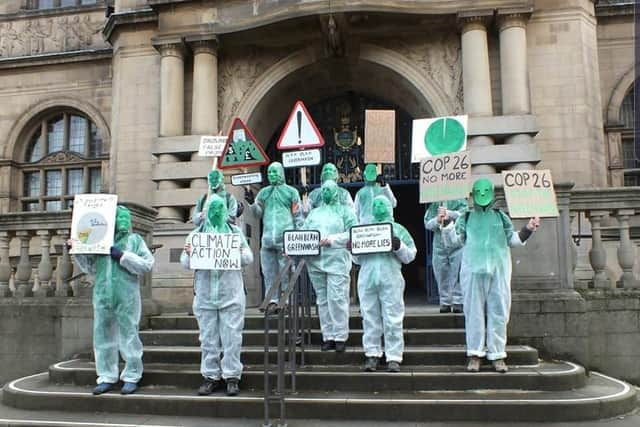"We must persuade COP26 world leaders to do better than this, our future depends on it"
and live on Freeview channel 276
In the run-up to COP26 it has been heartening to see the increased coverage in the media of the climate emergency. The BBC drama “The Trick” was TV at its best. But much of the coverage has annoyed me because it has focussed on personal lifestyle changes rather than the systemic change from Governments and Corporations that we need if we are to save ourselves from extinction.
The most annoying and frequent misinformation has been commentators speaking about climate change becoming “dangerous” when it reaches 1.5C.
Advertisement
Hide AdAdvertisement
Hide AdWe have already heated the planet by 1.2 degrees and this is already incredibly dangerous. We have experienced vast wildfires, monster hurricanes and droughts that ruined crops In Africa, the US, Canada and China. I am sure the residents of Fishlake in Doncaster will confirm that the warming we have already experienced is dangerous. Commentators should be more careful with their language.


Why did the Paris agreement put so much emphasis on the importance of avoiding 1.5 degrees of warming? When scientists talk about “dangerous” climate change they are pointing to the fact that we have to avoid a “hothouse earth” scenario. This is when feedback loops combine in a cascade so that the earth keeps heating up even if humans succeed in stopping our greenhouse gas emissions. The truth is scientists do not know at what temperature this will happen. Scientists have done an amazing job, modelling the different futures we can expect, depending on how successful we are at reducing emissions. But we are in completely unchartered territory, so these models can’t be relied on. Predicting the future has never been easy and these calculations have got to be the most complicated problem humanity has tried to solve. 1.5 degrees may be too optimistic, or too pessimistic. The 1.5 degrees was a round number, arrived at by the negotiators in Paris. Rich nations wanted it set at 2 degrees but island states and low lying nations realised that this would mean genocide for them, so they demanded 1.5. We can’t use it as a figure for which we are safe until it is crossed. Instead, we have got to maximise our efforts to reduce all emissions as quickly as possible.
Some feedback loops are already kicking in. In his book “Our Final Warning. Six degrees of Climate Emergency”, Mark Lynas identifies some of them.
“Arctic sea ice has been shrinking by 13% a decade since satellites began measuring it in 1978. That means that half of the entire Arctics stock of sea ice has disappeared and what remains has become 85% thinner...Because there is now dark-coloured open water during the summer rather than highly reflective snow and ice, solar heat absorption has increased fivefold since the 1980s in the once-frozen seas of Alaska and Canada, introducing vast quantities of energy into the Arctic system. ...While bright white snow-covered ice reflects 80% of the sun's heat that falls on it, the darker open ocean can absorb up to 95% of incoming solar radiation. Once the ice begins to melt the process quickly becomes self-reinforcing, more ocean surface is revealed, absorbing solar heat and making it more difficult for the ice to re-form next winter.”
Advertisement
Hide AdAdvertisement
Hide Ad“In the summer of 2019, the Arctic began to burn. In June more than 100 wildfires were burning above the Arctic circle, across Alaska, Siberia and Canada. Even Greenland saw wildfires erupting on fenlands scorched by unusual summer heat...the wildfires were not just burning trees. They were smouldering in dried-out peat, much of it formerly immobilised in permafrost. By the end of July, it was estimated that the blazes had released 120 million tonnes of CO2-an all-time record...All this extra carbon can only do one thing: accumulate in the atmosphere and cause more warming. These weren’t just wildfires, they were positive feedbacks showing that the heating of the Arctic is threatening to run out of control.”
With feedback loops already happening we must be perilously close to the hothouse earth scenario. Whatever the outcome of COP26, we must redouble our efforts to hold Governments and Corporations to account and ensure that emissions of greenhouse gases are reduced as quickly as possible. I don’t want to hear about targets for 2030, 2050 or 2060. I want to know what is being done now to reduce emissions.
The early announcements from COP26 have been weak.
Sheffield Peer Natalie Bennett explained why the plan to halt deforestation by 2030 was nothing to get excited about.
She commented “The now infamous and much-misused REDD+ (Reducing Emissions from Deforestation and forest Degradation) scheme emerged from the 2009 COP. A further agreement was reached in New York in 2014 to stop deforestation, yet 2016 witnessed a record 30 million hectares of forest disappearing – an area the size of Italy. Last year in Brazil alone, one million hectares fell before the chainsaws.” The plan seems to be little more than a target, with no means of enforcement. Similarly, the agreement to cut methane by 30% by 2030 is too little too late and lacks any teeth to enforce it.
We must persuade world leaders to do better than this, our future depends on it.